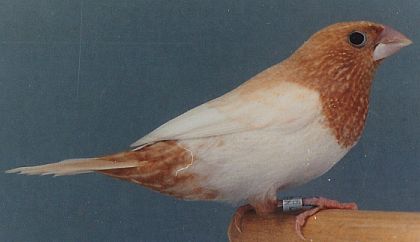
CLEARWING BENGALESE
It appears that at the present time there are two
types of the Clearwing mutation, one that originated in
The main difference in the two being, that whilst
the
The Dutch type is the one most likely to be found
in the U.K at the present time; I have heard that there are moves afoot
in
Clearwings are available in Chestnut, Fawn, and
Grey. As with all Bengalese mutations there are of course varying shades
of these colours ranging from very dark to dilute.
The ideal clearwing Bengalese should have a normal
coloured head, chin, throat, Upper breast, Rump, Tail and under tail
coverts.
The wings and mantel should ideally be white (or at
least as light as possible)
Giving a nice contrast between the two colours on
the birds.
It is thought the best way to breed clearwings is
to line breed them, and then to select the birds with the lightest wings
for your future breeding programme.
If possible you should try to avoid the use of
dilutes when breeding Clearwings, as this
will eventually lead to the head and tail colours becoming too
pale in colour.
You should also not be tempted to use any of the
variegated colours in with your Clearwings, this is sure to cause you
lots of problems with white feathers showing up in undesired places in
the future.
In my limited experience with clearwings I have
found that the wing colour on cock birds is more likely to be the colour
required by the show standards, whereas the hens will have slightly more
colour in the wings. Although this is not a problem when breeding
clearwings, you may find it better to show two cocks, and only use the
hens in the breeding room.
As with all other colours of Bengalese, Clearwings
should be shown in matched pairs,
But to find a Cock, and Hen, with the same colour
on the wings may be difficult particularly for the first year or so of
breeding. Once you have bred your stock and selected the best coloured
Clearwings to breed with for a few years, it may be possible to breed
cocks and hens that have the same wing colour.
There is no reason why you should not show two
hens, but they are most likely to be beaten by a pair with lighter
coloured wings.
The Clearwing mutation is Recessive, so it is
thought the best way to improve colour is to pair a Clearwing with a
good coloured normal bird, ie. Self Fawn, if you are breeding Fawn
Clearwings, Self Greys if breeding Grey Clearwings, and so on.
When using Self coloured birds in your breeding
programme all the chicks bred will be visual self’s, but will carry the
Clearwing factor in both Cocks and Hens.
Birds that carry the gene for another mutation in
their make-up that is not visual, are said to be split and are shown; Normal/Split
The Clearwing Bengalese appear to carry the Pastel
factor, so unfortunately the depth
of
colour visible on your chicks are likely to vary considerably, and even
nest mates can vary from very little colour to almost full colour.
One of the main features we should be looking for
in the clearwing mutation is the contrast of colour between the wings
and the coloured feathers on the rest of the bird.
So the darker the head, tail, etc, and the lighter
the wings, and belly, the more striking the bird will look
Introducing self’s into your stud of Clearwings is
not a quick fix; it will probably take one or two breeding seasons to
reap the full benefits.
The following information should give you an
indication of what to expect when you introduce
1st year; Normal Self Fawn Cock or Hen X Fawn
Clearwing Cock or Hen, will produce in theory. 50% Self Fawn/Clearwing
Cocks, and 50% Self Fawn/Clearwing Hens. There would be no visual
Clearwings produced from this pairing.
2nd year; pair best of your young split
Cock birds to Clearwing Hens, and the best split Hens to your best
Clearwing Cock.
You should then theoretically produce 50%
Clearwings, (Cocks or Hens), and 50% Normal/Clearwings.
It is possible to produce Clearwings by pairing two
split birds, but the chances are cut dramatically.
From this type of pairing you would theoretically,
produce: 25%
Only by test pairing the visual normals will you
find out those that are split for the Clearwing mutation and those that
are 100% normal.
Pairing Clearwing X Clearwing will produce 100%
Clearwing Cocks and Hens.
